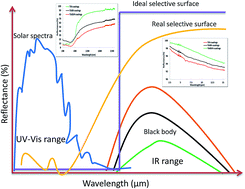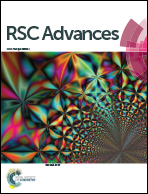Chemical bonding states and solar selective characteristics of unbalanced magnetron sputtered TixM1−x−yNy films†
Abstract
Transition metal nitride TixM1−x−yNy (M = Al or AlSi) based thin films are evaluated as solar selective surfaces by correlating their spectral selective features with their crystal structure and chemical bonding state including mechanical strength. Ti0.5N0.5, Ti0.25Al0.25N0.5, and Ti0.25Al0.2Si0.05N0.5 films were synthesized on AISI M2 steel substrates via closed field unbalanced magnetron sputtering technology. These were investigated using XRD, SEM, XPS, UV-Vis, FTIR and nanoindentation techniques. Analysis of the optical properties showed the solar absorptance, in the visible range, of the TixM1−x−yNy films improved significantly from 51% to 81% with AlSi-doping and an increase of solar absorptance of up to 66% was recorded from films doped with Al. Moreover, the Al doping can reduce the thermal emittance in the infrared range from 6.06% to 5.11%, whereas doping with AlSi reduces the emittance to ca. 3.58%. The highest solar selectivity of 22.63 was achieved with TiAlSiN films. Mechanical studies showed enhanced hardness by ∼32%; enhanced yield strength by ∼16% and enhanced plastic deformation by ∼110% of Al and AlSi doped TiN matrix.


 Please wait while we load your content...
Please wait while we load your content...